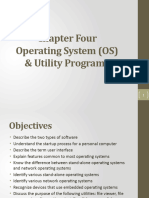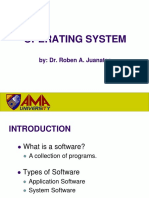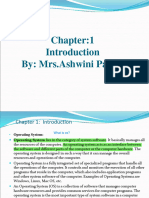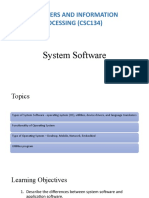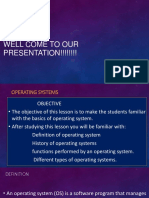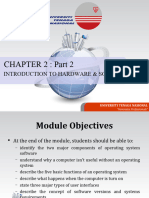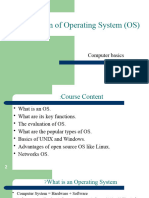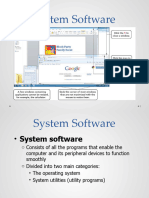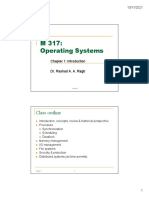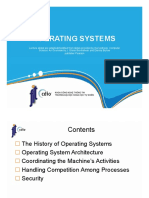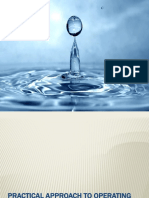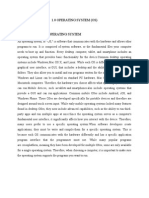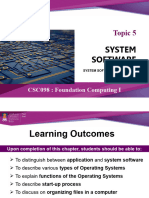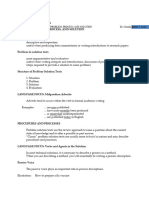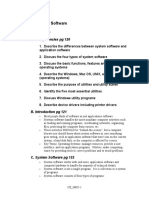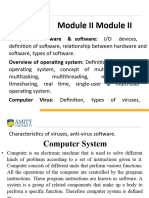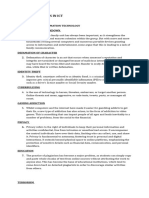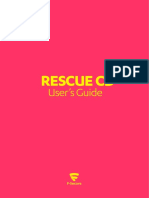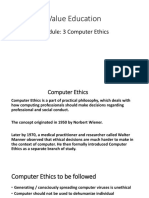05-Nov-24
Chapter 3
COMPUTER
SOFTWARE
Objectives of this chapter:
You can…
Identify the types of system software
Describe the functions of an operating system
Identify the types of operating system
Identify utility programs
Explain the purpose of the utilities program
1
� 05-Nov-24
Overview
• This chapter covers
– System Software
• Operating System
• Utility Program
Introduction
• Computer software is:
– A group of programs that connects user with
computer devices
– Comprised of a sequence of instructions
– Designed to instruct the computer to execute desired
functions by the users
2
� 05-Nov-24
Introduction (cont’d)
Software Layers
System Software
• What is system software?
Programs that
maintain operation
of computer
Two categories
Operating Systems Utility Programs
3
� 05-Nov-24
3.1 Operating System
Operating System
What is an operating system?
– A group of programs that organize and manage the
whole computer operations
– OS is a set of instructions that coordinate all the
internal activities among computer hardware,
application programs and users
4
� 05-Nov-24
Operating System (cont’d)
• OS is controlled by the kernel.
• What is a kernel?
– Kernel is the supervisor program that manage the
memory and devices
– Kernel is loaded into the memory from the hard disk
(or other storage) during booting until computer is
turned off
– It is known as memory resident (because it resides in
memory as long as the power is on. Non-resident are
other programs that resides in hard disk at the same
time)
Operating System (cont’d)
• The functions of an operating system
start the computer manage programs
(Booting) provide a user interface
administer
security
manage
memory
control a
network
provide file management establish an Internet
monitor schedule jobs and
and other utilities connection
performance configure devices
5
� 05-Nov-24
Operating System (cont’d)
• Booting
Process of starting or restarting a computer
Cold boot
Turning on
computer that has
been powered off
Warm boot
Restarting
computer that is
powered on
Operating System (cont’d)
• A personal computer boot up process
Step 1. Power supply Step 4. Results of POST are
sends signal to com- compared with data in CMOS chip
ponents in system unit Step 5. BIOS looks for system files
Step 2. Processor on a USB drive, in floppy disk drive
accesses BIOS to start or CD/DVD drive, and then hard
computer disk
Step 6. Kernel (core) of operating
Step 3. BIOS runs tests,
called the POST, to system loads into RAM
check components such Step 7. Operating system loads
as mouse, keyboard, configuration information and
and adapter cards displays desktop on screen
6
� 05-Nov-24
Operating System (cont’d)
• 4 main functions of OS:
– Manage computer programs
– Manage computer hardware
– Provides user interface
– Support application software
Operating System (cont’d)
• Manage computer programs
– Managing programs refers to how many users,
and how many programs, an operating system
can support at one time
– An OS can be single tasking, multi-tasking,
cooperative multi-tasking, preemptive multi-
tasking, multithreading and multiprocessing
– Single tasking
• Runs only one program at a time
7
� 05-Nov-24
Operating System (cont’d)
– Multi-tasking
• Same concept as multiprogramming
• Allows 2 or more programs at the same time
• Divide the programs into active and inactive. Active
application is called foreground application and
inactive application is background application
• CPU does not run the programs simultaneously but
manage the resources i.e. memory based on
active/inactive applications
Operating System (cont’d)
– Cooperative Multi-tasking
• Based on multi-tasking concept, whereby
foreground application controls CPU until program
ends
• But if program crashes/hang, OS needs to be
rebooted
– Preemptive Multi-tasking
• Based on multi-tasking concept
• But if program crashes/hang, OS is able to take
over CPU so other programs can be maintained
8
� 05-Nov-24
Operating System (cont’d)
– Multithreading
• One program may execute more than one task
• Example print and edit at the same time
– Multiprocessing
• Use of 2 or more processor at the same time
• Programs run simultaneously
• Each processor manage own resources
• Hardware dependant esp. motherboard
Operating System (cont’d)
• Manage computer hardware
– Memory Unit
• OS partitions the memory for each program.
• If memory is insufficient, OS may use virtual
memory, which allocates a portion of a storage
medium to function as additional RAM
• In virtual memory, programs/instructions are
stored in fixed-sized unit called pages
• If memory if full, OS will copy pages into swap file
in hard disk and reloaded into memory when
needed
9
� 05-Nov-24
Operating System (cont’d)
With virtual memory (VM), portion of hard disk is
allocated to function as RAM
Step 1. The
operating system
transfers the least
recently used data
and program
instructions to disk Step 2. The
because RAM is operating system
needed for other transfers data and
functions. program instructions
from hard disk to
RAM when they are
needed.
Operating System (cont’d)
– Input/Output Devices
• OS provides interrupt handler, a mini program to
handle interrupt from input/output devices.
• Examples of interrupt are mouse
click/scroll/keyboard punch
• OS requires device driver to operates hardware
devices. Drivers are loaded during booting
10
� 05-Nov-24
Operating System (cont’d)
• What is a device driver?
Program that With Plug and Play,
Play,
tells operating system operating system
how to communicate
Device
automatically configures
with device Driver new devices as you
Also called driver install them
Operating System (cont’d)
• Spooling
Sending print jobs to buffer instead of directly to printer
Print jobs line up in queue
11
� 05-Nov-24
Operating System (cont’d)
• Provides User Interface
• OS manages communication between the
computers and users
• Users may login, run application programs,
manage files (copy/save) and on/off computers
using any type of interface
• There are 3 types of command instructions:
i. Command line
– Instructions to be typed in i.e. to save a file into diskette
is C:\WINDOWS>copy C:myfile.doc a:
– Users have to memorize instructions
Operating System (cont’d)
ii. Menu-driven
– User selects instruction from a text-based pull-down
menu
– Instructions are entered either via mouse click/
keyboard <ENTER> of arrow keys
iii. Graphical user interface (GUI)
– User selects instruction by mouse click or keyboard
<ENTER> icons
12
� 05-Nov-24
Operating System (cont’d)
• User interface
Controls how you enter data and instructions and how information
displays on screen
command-line interface menu-driven interface
Operating System (cont’d)
• Graphical User Interface (GUI)
User interacts with
menus and visual
images such as icons
and buttons
13
� 05-Nov-24
• Some characteristics of operating systems
Proprietary
Device- Device-
software
dependent independent
Privately owned and
Runs only on limited to specific vendor Runs on many
specific type of or computer model manufacturers’
computer computers
Downward
compatible Upward
Works with application compatible
software written for Runs on new versions
earlier version of of operating system
operating system
• Three categories of operating systems
Embedded Network
Stand--alone
Stand
14
� 05-Nov-24
Operating System (cont’d)
Windows Version Year Released
Stand-alone operating Windows 3.x 1990
–
systems
Example: Windows Windows NT 3.1 1993
Windows 95 1995
Windows NT Workstation 4.0 1996
Windows 98 1998
Windows Millennium Edition 2000
Windows 2000 Professional 2000
Windows XP 2001
Windows XP SP2 2004
Windows Vista 2006
Stand-Alone Operating Systems
• Windows XP
Fast, reliable Windows
operating system
Available in five editions:
Home Edition, Professional
Edition,
Tablet PC Edition,
Media Center Edition,
and 64-bit Edition
15
� 05-Nov-24
Stand-Alone Operating Systems
• Windows Vista
Successor to Windows XP,
containing a new interface
and new / enhanced features
Available in several editions,
grouped into Home and
Business categories
Stand-Alone Operating Systems
• Mac OS X
Available only for
computers manufactured
by Apple
Macintosh operating
system has been
model for most GUIs
16
� 05-Nov-24
Stand-Alone Operating Systems
• UNIX
Used by power users
because of its flexibility
and power
Most versions
offer GUI
Available for
computers of all
sizes
Stand-Alone Operating Systems
• Linux
Popular, free, multitasking
UNIX-type operating system
Open-source software—
code is available to
public
Both a stand-alone
and a network
operating system Red Hat provides a version of Linux called Red Hat Enterprise
Linux.
17
� 05-Nov-24
Operating System (cont’d)
• Network operating system
Allows users to share printer,
Internet access, files, and
programs on a network
Administers security
by establishing user name and
password for each user
Network Operating Systems
NetWare
Designed for
client/server
• Examples of network networks
operating systems Windows UNIX / Linux
Server 2003 Multi--purpose
Multi
Upgrade to Windows operating system
2000 Server
Solaris
Version of UNIX
developed by Sun
Microsystems
Specifically for
e-commerce
applications
18
� 05-Nov-24
Embedded Operating Systems
• Embedded operating system
Found on most mobile computers,
PDAs, and other small devices
Windows CE is
scaled-down version of Windows
Embedded Operating Systems
• Operating systems for PDAs
Windows Mobile for Pocket PC
Palm OS for Palm
19
� 05-Nov-24
Embedded Operating Systems
• Embedded Linux
Scaled-down Linux operating system
designed for PDAs, smart phones,
smart watches, set-top boxes,
Internet telephones, and other
devices
Embedded Operating Systems
• Symbian OS
Open-source, multitasking operating system
designed for smart phones
Make telephone calls,
save appointments,
browse Web, send
and receive e-mail
and faxes, and more
20
� 05-Nov-24
3.2 Utility Program
Utility program
• A small program that provides an addition to the
capabilities provided by the operating system
• Performs maintenance-type tasks, usually related
to managing a computer, its devices, or its
programs.
21
� 05-Nov-24
OS Utility Program
• File manager
Performs functions
such as copying,
renaming, deleting,
and moving files
Image viewer displays
contents of graphics
file when you double
click on it
OS Utility Program
• Personal firewall
Detects and protects a
personal computer from
unauthorized intrusions
The latest update to
Windows XP
automatically enables
the built-in personal
firewall upon
installation
22
� 05-Nov-24
OS Utility Program
• Uninstaller
Removes a In Windows XP,
program and uninstaller is in Add/Remove
all associated files Programs in Control Panel
OS Utility Program
• Disk scanner
Detects and corrects
problems on hard disk
Searches for and removes
unnecessary files
23
� 05-Nov-24
OS Utility Program
fragmented disk
• Disk defragmenter
Reorganizes files and
unused space on hard
disk so programs run
faster
disk after
defragmentation
process
OS Utility Program
• Diagnostic utility
Compiles technical information about
hardware and some software
Prepares report outlining problems
24
� 05-Nov-24
OS Utility Program
• Backup utility
Copies selected files or
entire hard disk onto
another storage medium
Most compress files
during backup to require
less storage space
OS Utility Program
• Screen saver
Causes monitor’s screen to
display moving image or
blank screen if there is no
activity for a specified time
To secure computer, user
configures screen saver to
require password to
deactivate
25
� 05-Nov-24
Stand-Alone Utility Programs
• Antivirus program
Identifies and removes viruses in
memory, storage media, and
incoming files
Must be updated frequently
Stand-Alone Utility Programs
• What is a virus?
Potentially damaging computer program
Affects computer without user’s knowledge
• An unusual message or image is displayed on the computer
screen
• An unusual sound or music plays randomly
• The available memory is less than what should be available
SIGNS OF • A program or file suddenly is missing
VIRUS • An unknown program or file mysteriously appears
INFECTION • The size of a file changes without explanation
• A file becomes corrupted
• A program or file does not work properly
• System properties change
26
� 05-Nov-24
Stand-Alone Utility Programs
• Spyware
Program placed on a computer without the user’s knowledge that
secretly collects information about the user
Often enters a computer as a result of a user installing a new program
A spyware remover is a program that detects and deletes spyware
Stand-Alone Utility Programs
• Internet filters
Programs that remove or block certain items from
being displayed
Anti-Spam Web
Programs Filters
Pop-up
Blockers
27
� 05-Nov-24
Stand-Alone Utility Programs
• File compression utility
Shrinks size of files to free up room and improve
performance
Compressed files are sometimes called zipped
files
Two popular utilities:
Winrar and WinZip
Stand-Alone Utility Programs
• CD/DVD burning software
Writes text, graphics, audio,
and video files to a recordable
or rewriteable CD or DVD
28
� 05-Nov-24
Stand-Alone Utility Programs
• Personal computer maintenance utility
Identifies and fixes operating
system problems and disk
problems
Some continuously
monitor computer to
identify problems
before they occur
29
